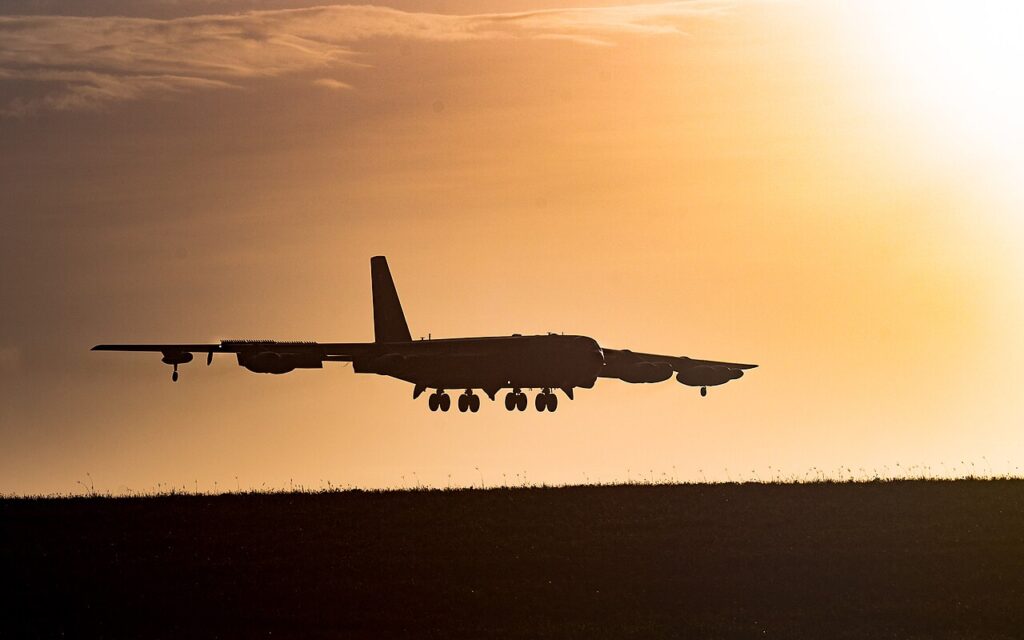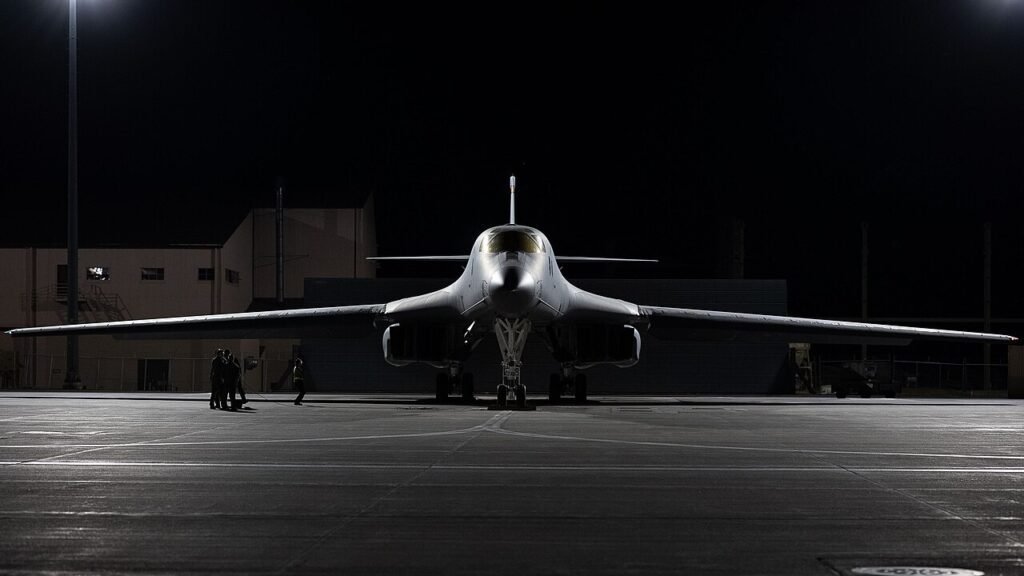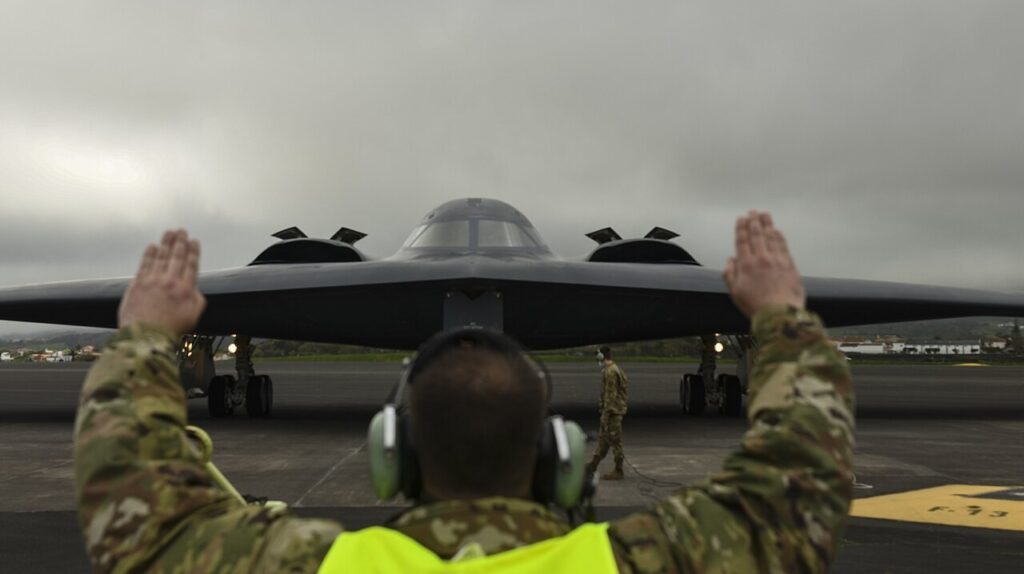The B-1B Lancer, B-2 Spirit, and B-52 Stratofortress form a complementary triad of strategic air power.
The US Air Force’s inventory includes three strategic bombers: the Boeing B-52 Stratofortress, Rockwell B-1B Lancer, and Northrop Grumman B-2 Spirit. Each bomber has a unique payload capacity, which affects its wartime application and reflects different design eras, mission doctrine, and strategic emphasis. While each of the three bombers can deliver either conventional or nuclear ordnance, each platform differs significantly in terms of maximum payload, delivery system, and doctrinal integration.
The Three Bombers’ Specifications
| Plane Name | B-52 Stratofortress | B-1B Lancer | B-2 Spirit |
| Role | Conventional bomber | Supersonic bomber | Stealth bomber |
| Year of Introduction | 1955 | 1986 | 1997 |
| Manufacturer | Boeing | Rockwell | Northrop |
| Number Produced | 744 | 104 | 21 |
| Number in Service | 76 | 45 | 19 |
| Cost Per Unit | $14 million (1950s) | $317 million | Approx. $20 billion |
| Cost Per Flight Hour | $88,000/hr | $173,000/hr | $150,000/hr |
| Wingspan | 185 feet | 137 feet | 172 feet |
| Top Speed | Mach 0.86 (650 mph) | Mach 1.2 at sea level (900 mph) | High subsonic |
| Ceiling | 50,000 feet | 30,000+ feet | 50,000 feet |
| Loadout | 70,000 lb | 75,000 lb | 40,000 lb |
| Size of Crew | 5 | 4 | 2 |
Sources: Boeing (1) (2), US Air Force (1) (2) (3), Government Accountability Office.
The B-52 Stratofortress Is the Largest in Its Class

The B-52 Stratofortress carries the second largest payload capacity of the three US strategic bombers—with the ability to carry up to 70,000 pounds of ordnance—despite being the largest aircraft overall. The B-52 payload can consist of nuclear or conventional weapons, including gravity bombs, cruise missiles, and smart munitions. The B-52 can also heft as many as 20 AGM-86B Air-Launched Cruise Missiles (ALCMs) externally on pylons and another eight internally, making the B-52 capable of performing a long-range standoff role.
In modern conflicts, such as the Gulf War, Operation Iraqi Freedom, or Afghanistan, the B-52 was used as a workhorse for sustained air campaigns—providing close air support and strategic bombardment. Despite being introduced in the 1950s, the B-52 is still relevant today, thanks in large part to the type’s massive payload capacity.
The B-1B Lancer Is Versatile

Developed during the latter half of the Cold War, the B-1B Lancer was designed to penetrate Soviet air defenses at low altitude and high speed. The only supersonic bomber in the US inventory, the B-1B, manages to carry 75,000 pounds of ordnance—slightly more than the B-52. However, as of 2007, the B-1B is no longer certified to carry nuclear weapons and can only be outfitted with conventional weapons. With an internal weapons bay, the B-1B is highly versatile, allowing for a broad mixture of ammunition such as JDAMs, cluster munitions, and long-range standoff weapons like the JASSM (Joint Air-to-Surface Standoff Missile).
The B-1B, despite being on the verge of retirement, has proven to be a valuable asset in modern air campaigns. With speed and agility, the B-1B has found a successful role in campaigns requiring a rapid response and flexible strike capability. Therefore, the B-1B played a significant role in Operation Allied Force in Kosovo, Operation Enduring Freedom in Afghanistan, and Operation Inherent Resolve against ISIS.
The B-2 Spirit Is the Stealthiest Strategic Bomber

The B-2 Spirit is the most technically advanced US strategic bomber and the only one with stealth capabilities. With a payload capacity of a relatively humble 40,000 pounds, the B-2 carries significantly less ordnance than her sister bombers, the B-1B and B-52. However, where the B-2 lacks in volume, it compensates for it in survivability and precision. Capable of delivering both nuclear and conventional ordnance, including B61 and B83 nuclear bombs, JDAMs, and the Massive Ordnance Penetrator.
With stealth capabilities and global range, the B-2 can penetrate heavily defended airspace and strike high-value targets with minimal warning. Accordingly, the B-2 has been used for early strike missions in Kosovo, Libya, and Syria, often being used to neutralize strategic targets.
In conclusion, the B-1B, B-2, and B-52 all play different roles, whose payload capacity significantly influences their effectiveness. The B-52 is geared for standoff mass firepower and endurance bombing, the B-1B is calibrated for flexible, rapid-response conventional strikes, and the B-52 brings unmatched stealth and precision for high-risk missions. Combined, the three bombers form a complementary triad of strategic air power.
About the Author: Harrison Kass
Harrison Kass is a Senior Defense and National Security Writer at The National Interest. Kass is an attorney and former political candidate who joined the US Air Force as a pilot trainee before being medically discharged. He focuses on military strategy, aerospace, and global security affairs. He holds a JD from the University of Oregon and a master’s in Global Journalism and International Relations from NYU.
Image: Wikimedia Commons.


















